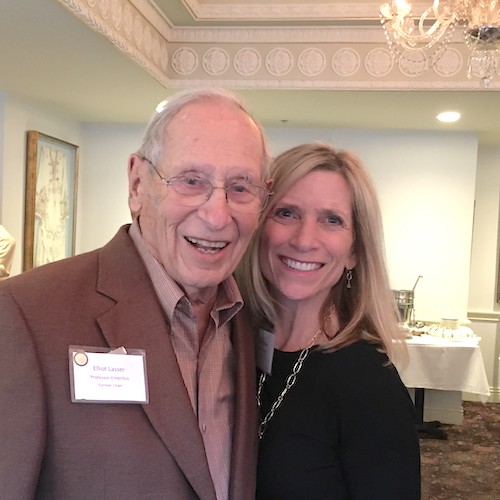About Dr. Elliot Lasser
Dr. Lasser, M.D., Professor Emeritus of Radiology, in his own words:

Dr. Elliott Lasser, MD, with Jo Ann Nelson, Assistant for the Chair of the Department of Radiology
"When I went off to college, I thought rather loosely that I would 'Go into business.' How had I arrived at that decision? Simply because my father, a businessman, worked in a downtown Buffalo office filled with plush leather couches and chairs, an inviting environment.
"With this luxury in mind, I thought that my learning experience at Harvard, should begin by getting myself a position as a business editor on the college magazine, the Crimson, which I quickly did.
"I spent a year chasing down ads for the Crimson, an activity I despised. Near the end of that year, however, I came upon a book (by Upton Sinclair, assisted in the preparation by Dr. Paul de Kriuf, a noted science writer) about a young man that, shortly after finishing medical school, volunteered to travel to an epidemic area somewhere in South America. In short, he emerged as a great hero after solving some essential fault in the existing therapy for the virus. I was Turned On!
"My own research experience began when my mentor in Radiology at the U. of Minnesota Medical School asked me to learn something about the ileocecal valve that radiographically posed as a tumor at the ileocecal junction. Imagining how some fictional doctor might have tackled this, I plunged in head first and began to experience the heady feeling that comes with unlocking some of Nature's secrets. I carried the quest far beyond what my mentor (Dr. Leo Rigler) had in mind, and it all ended in my receiving an MS in Radiology for the pamphlet I produced on the subject.
"My next pivotal experience in research came when I set out to explore the role of injection speed in releasing histamine from mast cells in a series of dogs. Knowing that the lungs were a rich source of mast cells, we put a catheter in the pulmonary artery for injection of contrast, and another catheter in the left ventricle to collect released histamine. We used two different injection speeds: 2 seconds/mL vs. 32 seconds/mL to inject the same amount of contrast. I fully expected the rapid injection would produce greater histamine release. To my great surprise, it was exactly the opposite!
"It took me ten years to get the answer to this. After conducting another experiment that also ended somewhat contrary to expectations (RBC hemagglutination inhibition) the light came on: Fast injections inhibited histamine release!
"Now I had to come up with an explanation for this. After considerably more reading, and helped by facts I learned from the RBC hemaggutination study (i.e., that while attachment to the immunoglobulins IgG or IgE was thought to cause the contrast injection release of mast cell contents, the attachment had to be at the constant portion [Fc] of the molecules rather than at the expected variable portion [Fab].) Armed this knowledge, it occurred to me that the attachment of large amounts of our contrast media to the shafts of the immunoglobulins might very well prevent the approximation of adjacent IgE molecules known to be necessary for mast cell release by virtue of steric hindrance.
"Subsequently, we did many experiments to nail down the above concepts. We knew that the contrast media, acting as they do on mast cell activities, must represent a new approach to the treatment of allergic conditions. We reasoned that allergic symptoms would be inhibited anywhere we placed our mast cell inhibiting media. This proved true in two tests that we ran on nasal allergy. In each of these tests, we exposed known allergic patients to antigens we knew induced allergic rhinitis in them, in both the presence and absence of our contrast media placed intranasally.
"To conclude, I will simply say that the dynamics we learned from our research have led us to consider some additional applications of mast cell inhibition. Currently, we are working on the role of the media in inhibiting various viruses, easing the pain of migraines, inhibiting the common cold infections, clearing atopic dermatitis, and a few other things. I have an abiding curiosity and am very grateful for what this has engendered in me."
